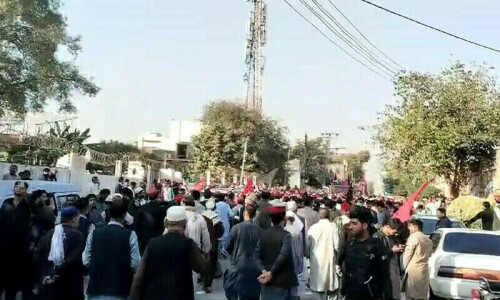THE history of Urdu prose in northern India begins with Karbal Katha. It was also known as Dah Majlis, a misnomer popularised by the fact that the book was read out during the congregations held in the first 10 days of Muharram. The word Karbal refers to Karbala and katha means a story.
Karbal Katha was written in 1145 Hijri/1732-33 AD and reviewed and fine-tuned by author himself in 1161 Hijri/1748 AD. Urdu prose in the South, or Deccan, had begun a couple of centuries ago, with Sabras by Mulla Vajhi (1635) being the first literary work ever written in Urdu prose. The arrival of Vali Dakkani’s Urdu divan in Delhi in the early years of 18th century was a shot in the arm of Urdu literature. With a remarkable increase in Urdu’s popularity in the North among the masses, poets began composing poetry in Urdu instead of Persian. But Urdu prose in northern India was virtually non-existent till Karbal Katha was penned. Hence, says Haneef Naqvi, Karbal Katha’s author, Fazl Ali Fazli, should be acknowledged as being the first author to have taken the bold step of acknowledging Urdu’s popularity among the commoners by writing a book in Urdu prose instead of Persian.
When the catalogue of books and manuscripts owned, and later on donated, by Aloys Sprenger (1813-1893) published in 1857, titled A Catalogue of the Bibliotheca Orientals Sprengeriana, it also listed Dah Majlis at serial number 173, under the section ‘Geography and History’, with the brief description that follows verbatim: “The tragical hist. of the death of Hosayn and his relations in prose and verse by Fadhly, who flourished under Mohd.-shah” (page 12).
Interestingly, till 1950s, none of the critics writing about Karbal Katha had ever seen a copy of the work and all of them, including Muhammad Husain Azad, had simply repeated, either partially or wholly, what Moulvi Kareemuddin had said in his Tabaqaat-i-Shuaraa-i-Hind (1848). Mohiuddin Qadri Zor expressed his doubts saying it was not sure even if the book existed, since nobody had seen it, though Garcin de Tassy, too, had mentioned it. No one except Kareemuddin and Sprenger had seen the original manuscript of the work and perhaps it was one and the same manuscript as Kareemuddin had probably handed over his copy to Sprenger.
So when Mukhtaruddin Ahmed went to Europe for his research work, Qazi Abdul Wadood asked him to trace the manuscript. Finally Mukhtaruddin Ahmed discovered the manuscript in 1955 from Sprenger’s collection in Germany. He had a facsimile of the text but could not edit or publish it. So Khwaja Ahmed Farooqi procured a copy of the text and announced that it would be launched at Delhi University’s Urdu department by Jawaharlal Nehru, the then prime minister of India. It was launched in 1961, but the edition was not made public for unknown reasons, as mentioned by Gian Chand in his book Tajziye. But Mukhtaruddin Ahmed in collaboration with Malik Ram prepared an annotated edition and published it in 1965. Farooqi’s version, printed in 1961, was released after that.
Karbal Katha was in fact based on Rauzat-ush-Shuhadaa, a much popular Persian work by Mulla Husain Vaaiz Kaashifi. The popularity of Kaashifi’s work in subcontinent can be measured by the fact that the phrase ‘rouza khawni’ came to connote description of martyrdom of Imam Husain during religious gatherings. Abridged Persian versions of Kaashifi’s work too were popular and were recited during Muharram but some of the audience, especially women, could not understand fully, as mentioned by Fazli, so he decided to write it in Urdu. Rauzat-ush-Shuhadaa has 10 chapters, but Karbal Katha has 12 and a “khatema” (ending) that has five chapters. The “fatehas” and adulatory verses are also added by Fazli.
Critics seem to disagree on Karbal Katha’s literary value, but all admit that it is a milestone in the history of Urdu prose and holds a special status from linguistic point of view since it has certain clues on the development of Urdu language in northern India. As for the language of Karbal Katha, it has two distinct styles at the same time: one is ornate Urdu prose, on the pattern of once-popular Persian prose, and the other is simple, since the book was intended for less educated and women, notes Jameel Jalibi.
Farooqi’s edition retains the orthographic peculiarities, which are indeed helpful for the researchers tracing the history of Urdu language and its orthographic changes that took place over the centuries, but common reader could face difficulties in deciphering the ancient spelling rules. The version edited by Mukhtaruddin and Malik Ram has detailed index in addition to annotations.
Fazl Ali Fazli is rightly credited for initiating a tradition of Urdu translations from Persian, though he did not have a sample work or example before him.
Published in Dawn, June 17th, 2024













































Dear visitor, the comments section is undergoing an overhaul and will return soon.